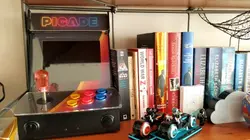Open Hardware/Modding: Raspberry Pi and Arduino Stories
-
How to Set Up RetroPie on Raspberry Pi 4 (or earlier) | Tom's Hardware
In the 1980s and 1990s, the arcades were the place to be. The latest games ate our quarters as we pursued ever higher scores. Those days are now sadly behind us but retro gaming has seen massive growth in the past decade.
Using a Raspberry Pi, you can run a variety of emulators that allow you to play not only old-time arcade games, but also your favorite titles from tons of old consoles, including the Atari 2600, NES, Nintendo 64, Sega Genesis and Gameboy. There are a number of emulation platforms available, but RetroPie is by far the most popular and arguably the best.
-
Raspberry Pi Creators Honored With Museum Fellowship | Tom's Hardware
Raspberry Pi (opens in new tab)'s Liz and Eben Upton, the chief marketing and communications officer and CEO of Raspberry Pi Ltd, respectively, have received honorary fellowships from the UK’s National Museum of Computing (opens in new tab) for their services to computer science.
-
Raspberry Pi Hoverboard Project Rolls in for a Ride | Tom's Hardware
When it comes to tech, sometimes it’s just more fun to build the gadget yourself — and what better tool could you ask for than the Raspberry Pi? Maker and developer Orhan Günsal apparently had the same thought when devising this Raspberry Pi-powered hoverboard project. Not only is it Pi-powered, but it’s got additional features that take it to the next level with wireless support.
This hoverboard is fitted with four wheels, each controlled by the Raspberry Pi using 250-watt motors. In a demo video of the project shared by Günsal, he shows off the mobility of his custom Pi-powered hoverboard using a web interface with a few pre-programmed control options.
-
DIY vacuum gauge controller saves big money | Arduino Blog
Measuring vacuum works in the same way as measuring any other gas pressure, because a perfect vacuum is unachievable and so it is a measure of how close to zero the air pressure inside a container becomes. But typical pressure gauges aren’t meant to measure pressures below ambient atmospheric pressure (vacuums). That requires special sensors and Advanced Tinkering built his own vacuum gauge controller to handle them.
The vacuum sensors that Advanced Tinkering purchased were designed for use with a proprietary controller that costs thousands of dollars. The sensors don’t just send an analog signal corresponding to pressure level (which would be very easy to read), but also status information. Even with that added complexity, the proprietary controller is very expensive for what it is. Advanced Tinkering correctly assumed that he could replicate its functionality with affordable off-the-shelf hardware. The communication protocols for his sensors are well-defined in published documents, which made them much easier to work with.

